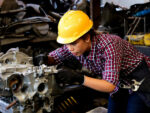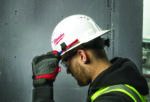A mechanics’ job is basically to fix, build, or maintain any kind of machinery. This means they have to work with all kinds of tools, objects, equipment, etc. Such a job involves risks that can lead to severe injuries.
Therefore, mechanics have to wear safety gear when working to make sure they protect themselves from any such accident.
And accidents occur unannounced so it is better to be safe than sorry. Being covered from head to toe in protective clothing is ideally what is best for a mechanic as well.
Considering protecting the head is just as important as shielding any other part of the body, OSHA has suggested that even mechanics should wear hard hats as a part of their PPE gear. There is always some sort of risk involved in a mechanic’s day-to-day work.

However, you will not see every mechanic out there wear a hard hat because not each type of mechanic works in an accident-prone environment.
Depending on the type of machines that mechanics work on, they are categorized under two classes, such as heavyweight and lightweight.
The former type of mechanic works with large machines and equipment, whereas, the latter type of mechanic works with small machines, equipment, and items.
This more or less decides for a mechanic whether wearing a hard hat is really required. It all boils down to the employer, if they are following OSHA’s guidelines then every mechanic has to wear a hard hat for their own safety.
We will learn more on the subject in this article as we discuss the various advantages or benefits a mechanic has when he or she wears a hard hat while working. I have also explained the different types of hard hats that are available in the market, which are approved by OSHA and ANSI.
What are the benefits of wearing a hard hat?
Hard hat as we know is a part of the PPE kit for jobs where there are risks of serious injuries. Therefore, naturally, there are several advantages of wearing a hard hat to work for mechanics as well.
1.) Protection from falling objects
A hard hat protects your head from getting injured caused by possible objects falling on your head. This is one of the most important reasons why hard hats are required at a job site where there is a possibility of things falling accidentally.
2.) Electrical hazard protection
Some hard hats are equipped to protect you from getting electrical shocks. Not all mechanics work with electrical tools or around electricity, but the ones who do, have to make note of covering their head from such accidents as well. Hence, a hard hat comes into play in such a scenario.
3.) Protection against head bumps
There is a possibility of banging your head against objects that are sticking out such as pipes and beams. It is best to protect your head with a hard hat from such unfortunate accidents.
4.) Protection from burning
There are hard hats that come with features of being resistant to burning, thereby protecting your head from getting burnt.
5.) Shocks to the head
Hard hats can absorb shocks caused by your head being blown by any heavy object. It reduces the impact of such objects in case it comes crashing on your head.
6.) Water-resistant
Hard hats can also protect your head from getting wet as they have water-resistant features as well.
7.) Resistant to penetration
Wearing a hard hat can prevent you from severe head injuries caused by sharp objects that can penetrate through your skull.
See also: Best Work Gloves for Mechanics
Types of hard hats that are approved by OSHA and ANSI
There are two different types of hard hats along with three different classes of hard hats to meet the ANSI requirements. They are classified into these categories based on the impact and electrical performance.
First, there are Type 1 hard hats, which shield the head from the top, thereby protecting it from any falling objects that can cause damage to the head. It comes with a full-beam that surrounds the dome of the helmet.
Second, we have the Type 2 hard hat, which protects the head from the top as well as from the sides. These hard hats feature a foam lining on the inside and a short rim like that of a baseball cap in the front.
The three classes include;
1.) Class G Helmets, where G stands for General. These hard hats have the ability to minimize the impact of objects falling on the head and also protection against the low-voltage electrical charge. To be more precise it can protect you from 2200 volts of electrical charge maximum.
2.) Class E Helmets, where E stands for Electrical. These hard hats help in minimizing the danger of electrical shocks caused by a maximum of 20000 volts of electrical charge. This hat also reduces the impact of objects falling on the head.
3.) Class C Helmets, where C stands for Conductive. These hard hats do not provide any protection against electrical hazards but are conductive hats that reduce the impact of falling objects on the head.
The hard hat that a mechanic has to wear will solely depend on the kind of industry he or she works in. Therefore, it is important for a mechanic to understand that all hard hats are not the same and they will not provide the same kind of protection against head injuries.
It is also important that in case the hard hat cracks, dents, and punctures, you need to change it immediately. Failing to do so can lead to serious issues at a later stage.
See also: Best Safety Glasses for Mechanics
Wrapping up
To conclude, hard hats are not only meant for people in construction or any such occupation. Any job where there is a chance of having a head injury, wearing a protective helmet should be a mandate.
When OSHA makes certain guidelines for the safety of the workers who work in an accident-prone environment, they should be followed diligently. Why risk your life by not wearing the appropriate safety gear when working in such a workplace.
A head injury can easily lead to something as crucial as death, and in order to avoid such a terrible thing from happening a mechanic should always wear a hard hat no matter how hazardous the work environment is or is not.
You must ensure that the helmet meets all the safety standards that are put out by ANSI, and provide complete head protection.







